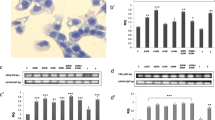Summary
A series of compounds structurally similar to the specific Leydig-cell-cytotoxic substance ethane-1,2-dimethanesulphonate (EDS) were examined for Leydig cell toxicity in the rat. Within 48 h of a single injection of butane-2,3-dimethanesulphonate (BDS), propan-1,3-dimethanesulphonate (P-1,3-DS) or propan-1-chloro-2,3-DS (PCDS) there was a reduction in serum and testicular testosterone levels. The serum luteinizing hormone (LH) concentration was reduced following BDS or P-1,3-DS, and Leydig-cell LH receptors (measured by125I-labelled hCG binding) were reduced by <15%, from which it is concluded that these compounds are not selectively toxic to Leydig cells. However, PCDS reduced human chorionic gonadotropin (hCG) binding by >70% and could be considered to be a potential toxin. The effects of hydroxyethanemethane-sulphonate (HEMS), 1,5,2,4-dioxadithiepane-2,2,4,4-tetraoxide (cyclic SOSO), PCDS, propan-2,3-DS, α-chlorohydrin and cyclohexane-1,2-dimethane-sulphonate were compared with the effects of EDS 7 days after injection. Systemic toxicity, indicated by a loss of body weight, was associated with cyclic SOSO, PCDS and EDS, although only EDS and PCDS reduced both testicular hCG binding and serum and testis testosterone levels consistent with Leydig-cell toxicity. Further studies indicated that the potency of PCDS in reducing testicular hCG binding and serum and intratesticular testosterone levels was similar to that of EDS. However, unlike EDS, PCDS was systemically toxic and also reduced LH, which could at least in part account for changes in testosterone secretion. The experiments confirm the unique cytotoxicity of EDS. Loss of specific Leydig-cell cytotoxicity and an increase in systemic toxicity occurred when the EDS molecule was altered, even if the distance between the alkylating centres was maintained. The mechanism of action of EDS remains elusive.
Similar content being viewed by others
References
Bowman S, Leake A, Miller M, Morris ID (1981) Agonist and antagonist activity of enclomiphene upon the oestrogen mediated events in the uterus, pituitary gland, and brain of the rat. J Endocrinol 88: 367
Catt KJ, Ketelslegers J-M, Dufau ML (1976) Receptors for gonadotrophic hormones. In: Methods in receptor research, vol 1. Marcel Dekker, New York, p 175
Cooper ERA, Jackson H (1970) Comparative effects of methylene, ethylene and propylene dimethanesulphonates on the male rat reproductive system. J Reprod Fertil 23: 103
Debeljuk L, Arimura A, Schally AV (1973) Pituitary and serum FSH and LH levels after massive and selective depletion of the germinal epithelium in the rat testis. Endocrinology 92: 48
Edwards K, Craig AW, Jackson H, Jones AR (1969) Studies with alkylating esters: I. The fate of ethylene dimethanesulphonate. Biochem Pharmacol 18: 1693
Ericsson RJ, Baker HWG (1970) Male antifertility compounds: biological properties of U-5897 and U-15646. J Reprod Fertil 21: 267
Furr BJA, Valacchia B, Curry B, Chesterson G, Tucker H (1987) ICI 176,334: a novel nonsteroidal, peripherally selective antiandrogen. J Endocrinol 113: R7
Gibson NW, Hartley JA, Kohn KW (1986) The DNA reactivity and in vitro cytotoxicity of the novel antitumor agent 1,5,2,4-dioxadithiepane-2,2,4,4-tetraoxide (NSC-348948). Cancer Res 46: 1679
Gomes WR, Hall RW, Jain SK, Boots LR (1973) Serum gonadotrophin and testosterone levels during loss and recovery of spermatogenesis in rats. Endocrinology 93: 800
Haddow A, Timmis GM (1951) Bifunctional sulphonic acid esters with radiomimetic activity. Acta Union Int Contre Cancrum 7: 469
Haddow A, Timmis GM (1953) Myleran in chronic myeloid leukaemia; chemical constitution and biological action. Lancet I: 207
Jackson AE, O’Leary PC, Ayers MM, Kretser DM de (1986) The effects of ethylene dimethane sulphonate (EDS) on rat Leydig cells: evidence to support a connective tissue origin of Leydig cells. Biol Reprod 35: 425
Jackson CM (1975) Mode of action of certain male antifertility chemicals with special reference to hormone control. PhD Thesis, University of Manchester
Jackson CM, Jackson H (1984) Comparative protective actions of gonadotrophins and testosterone against the antispermatogenic action of ethane dimethansesulphonate. J Reprod Fertil 71: 393
Jackson H (1966) IV. Alkylating Agents. In: Antifertilibity compounds in the male and female. Charles C. Thomas, Springfield, p 55
Jackson H, Craig AW (1969) Effects of alkylating chemicals on reproductive cells. Ann N Acad Sci 160: 215
Johnson LA, Pursel VG (1972) Reversible infertility in male swine fed α-chlorohydrin. J Anim Sci 34: 241
Jones AR (1978) The antifertility actions of α-chlorohydrin in the male. Life Sci 23:1625
Jones AR, Campbell ISC (1972) Studies with alkylating esters: V. The reactions, metabolism and biological activities of some cyclic dimethanesulphonates; the relevance to the mechanism of action of myleran. Biochem Pharmacol 21: 2811
Kalla NR, Bansal MD (1977) In vivo and in vitro alkylation of testicular cysteine by alpha chlorohydrin. Indian J Exp Biol 15: 232
Kerr JB, Bartlett JMS, Donachie K (1986) Acute response of testicular interstitial tissue in rats to the cytotoxic drug ethane dimethanesulphonate. An ultrastructural and hormonal study. Cell Tissue Res 243: 405
Miyachi Y, Vaitukaitis JL, Nieschlag E, Lipsett MB (1972) Enzymatic radioiodination of gonadotrophins. J Clin Endocrinol 34: 23
Morris ID, McCluckie JA (1979) Temporal changes in serum androgen after temporary impairment of Leydig cell function by ethane-1,2-dimethanesulphonate. J Steroid Biochem 10: 467
Morris ID, Phillips DM, Bardin CW (1986) Ethylene dimethanesulfonate destroys leydig cells in the rat testis. Endocrinology 118: 709
Morris ID, Bardin CW, Musto NA, Thau R, Gunsalus GL (1987) Evidence suggesting that germ cells influence the bidirectional secretion of androgen binding protein by the seminiferous epithelium demonstrated by selective impairment of spermatogenesis with busulphan. Int J Androl 10: 691
Rommerts FFG, Grootenhuis AJ, Hoogerbrugge JW, Molen HJ van der (1985) Ethane dimethane sulphonate (EDS) specifically inhibits LH stimulated steroidogenesis in Leydig cells isolated from mature rats but not in cells from immature rats. Mol Cell Endocrinol 42: 105
Author information
Authors and Affiliations
Rights and permissions
About this article
Cite this article
Edwards, G., Jackson, H. & Morris, I.D. Testicular endocrine effects of alkane methanesulphonates related to the Leydig cell cytotoxic compound, EDS. Cancer Chemother Pharmacol 26, 19–25 (1990). https://doi.org/10.1007/BF02940288
Received:
Accepted:
Issue Date:
DOI: https://doi.org/10.1007/BF02940288




